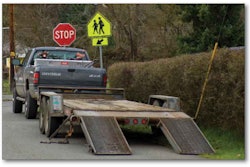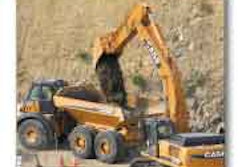Wirtgen America
Hydraulics give new concrete slipform pavers field-friendly convenience; new compactors bring big paver features to smaller sizes
By Tom Jackson
 Over the past several months and in several different venues, Wirtgen America has introduced a slate of new and improved machines for the road building industry.
Over the past several months and in several different venues, Wirtgen America has introduced a slate of new and improved machines for the road building industry.
The big news is Wirtgen’s North American entry into the concrete slipform paver business with two models, the SP 25 and SP 15. Both machines are designed to lay curb and gutter, concrete barriers, sidewalks, ditches, slabs and special applications.
Wirtgen has made slipform pavers for Europe and other markets for decades, but the SP 15 and SP 25 represent the first company entries into the U.S. market. Eventually a full line, including the SP 500, SP 850, SP 1500 and SP 1600 will be marketed in America, according to Wade Bowman, national sales manager for Wirtgen concrete slipform pavers.
The two pavers have a number of design elements in common. When your operating environment is congested or restrictive, the SB 15 and SB 25 allow you to pave on either the right or left side of the machine. And changeovers can be made quickly and easily in the field. On both machines the molds telescope hydraulically for paving inside or outside of the machines’ footprint. And the mold attachment system allows the operator to drive into the mold, hydraulically secure it to the paver, then unlock it and drive away from it when the job is done.
Both machines can be set up for guidance from a stringline, slab tracers or stringless control. The trimmers were designed with helical cutters and input from Wirtgen’s milling machine group. The trimmer’s extension, slope and horizontal and vertical positions are all set hydraulically.
The SP 15 travels on three independently steerable crawlers. The SP 25 offers three or four crawlers. But on both machines the two front crawlers are mounted on hydraulically actuated arms that swing out wide of the machine’s footprint for stability and a tight, variable turning radius.
Concrete can be fed to the pavers with belt or auger conveyors. The conveyors are hydraulically adjustable in all directions for flexibility in loading and jobsite conditions. Large hoppers on the receiving end ensure a steady flow of concrete.
Options include electric or hydraulic vibrators with adjustable vibrating frequencies, a high pressure cleaner that allows you to clean the machine at the site, and custom built molds. The main difference between the two machines is size and capacity. See the chart below left for details.
Hamm fills in compactor line
The new Hamm HD + 90 and HD + 110 articulated tandem rollers – at 10- and 11.5-metric tons respectively – bring the company’s HD + design and technology into a new, lighter weight class.
The new models feature an extra large cab with vaulted fiberglass roofs. The operator console is permanently attached to the seat, which slides from side to side and swivels 180 degrees for an unobstructed view of either edge of the drum.
A redesigned articulated joint offers better weight distribution and directional stability while improving compaction quality in bends and curves. The amount of offset during crab steering is almost doubled.
With their 66-inch drums, both models are offered with a variety of options including conventional vibration, high frequency compaction (4,020 vibrations per minute), Hamm oscillation compaction* or standard vibration in front and oscillation compaction in the rear drum. The HD + 90 has an operating weight of 10 metric tons and the HD + 100 weighs in at 11.5 metric tons. All the plus (+) models offer the Hammtronic engine management system with programmable speed controls, independent control of drum vibration and frequency and fuel savings.
Hamm also introduced a new pneumatic rubber tire roller. The speed and direction of the GRW 280 is controlled by joysticks rather than a pedal protruding into the operator’s foot space, and the machine operates much like a tandem drum roller reducing the need for operators to adapt or learn a new system. A new steer axle up front and disc brakes ensure sufficient stopping power even with maximum load. The GRW 280 is being launched in multiple weight classes, including 10-, 15-, 20-, 25-, and 30 tons.
Hamm also relaunched its compact line with drum sizes ranging from 31 to 54 inches wide with Kubota diesel engines and new drivetrain components. The rollers have also been redesigned for quicker servicing and simpler maintenance with all the service points for the drive units on the same side. EW

















